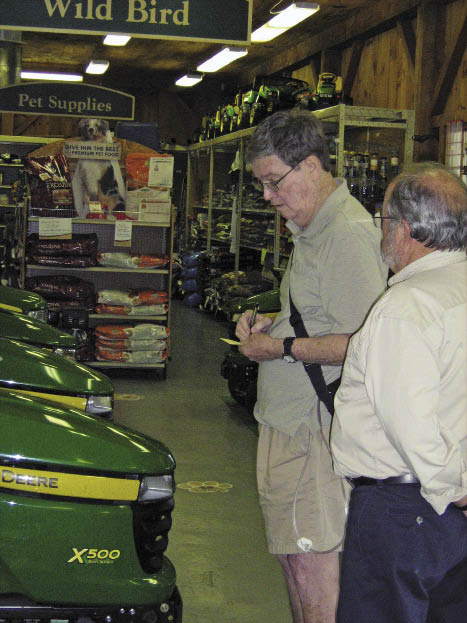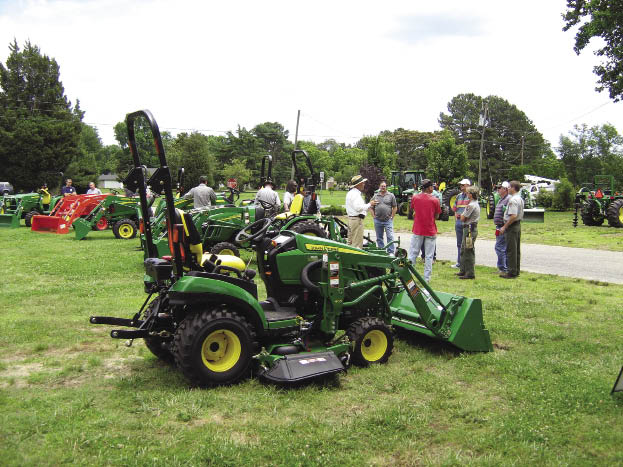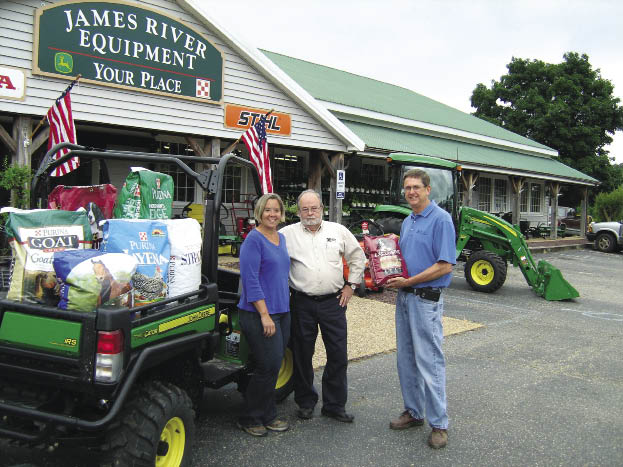Many of your customers have made the lifestyle choice to buy property in the country and move back to the land. And your dealership has successfully helped them buy and service the equipment they need to manage their property. But would you be able to lend a hand if they pulled up to your dealership with a baby goat in the backseat of their car?
If you are the Coufal-Prater John Deere dealership in Navasota, Texas, the answer would be a resounding “yes.”
“That is a true story, by the way,” says David Record, general manager of the dealership. “We had a customer who just couldn’t help but buy that cute little kid goat at the local auction barn. And they just drove right up to the dealership to ask us what to feed it.”
Since they sell feed in addition to equipment, they were able to help.
You will see the gamut of customers in terms of education and knowledge when you are selling feed to the rural lifestyle market, just like with equipment sales, says Record.
“We have customers who are more like the goat customer, and we have those that will spend hours and hours researching feed for their animals and call us up and ask for it by name,” he says.
Coufal-Prater Equipment is a full-line John Deere dealership with five locations throughout Texas. Starting about six years ago, the Navasota store also began selling Purina Mills animal feed, in addition to tack, pens and other animal health products.
Record says the original intention behind adding the feed component to the equipment dealership was to try to balance out revenue throughout the year.
“We were hoping that the feed section would be busy at the time of the year that the equipment side was slowing down a little bit. To some extent that is true, but it’s not as clearly defined as we had predicted. They overlap much more than we thought they would.”
In response, Record hired more personnel.
“But we couldn’t afford to keep hiring to keep up with the flow of traffic. It just didn’t make sense to have our retail staff constantly busy, while the equipment sales staff didn’t have enough to do. So we began cross-training our parts department personnel.”
The intention, says Record, was not to make feed experts out of the parts guys, but they did hope to give them at least a working knowledge of the types of feed for sale so they could easily help customers who already know what they need.
James River Equipment is another John Deere dealership that also sells animal feed. They don’t cross-train sales personnel, however.

Caleb Brickhouse, who handles equipment sales with James River Equipment, counsels a prospective customer.
“Our equipment salespeople are not cross-trained to sell feed,” says Kevin Nuckles, feed manager for the Toano, Va.-based dealership. “And with one exception, feed sales people do not sell equipment. Both, however, are encouraged to refer each other. I think farm supply sales people could easily be trained to help with mower sales and even sales of utility vehicles, but using the same people to do both is a poor choice overall.”
Different Sales Process
Nuckles attributes this to the fact that the sales process for equipment sales is vastly different than the sales process for feed and supply sales
“An equipment sale requires more time and can become very detailed depending on customer needs,” he says. “In contrast, most feed sales, following an initial consultation, are more transactional.”
The James River store carries many different types of feed: deer and wildlife, wild bird, caged bird, pet and livestock feed, and even zoo (camels and monkeys, for example) and lab diets (rodents and rabbits). Selling bird seed to a lifestyle customer is just a very different process than selling a tractor. This difference can be a challenge for equipment dealerships that choose to diversify into feed.
Record says it was this aspect that presented the steepest learning curve for Coufal-Prater when it first started selling feed. It still presents challenges today.
“On the equipment side of the business, we can buy a machine from the supplier, literally stick it out in front of our dealership priced with a certain percent margin and sell it,” he says. “On the retail side, we are constantly checking competitor prices and watching that aspect of things. It is a totally different way of doing business.”
Also, says Record, while sales and marketing advice from their feed supplier has certainly been very helpful, it has been a bit of trial and error to find out what types of feed work best for customers in their region.
“We have a bit of a unique situation,” says Record. “The largest producers’ co-op in the nation is about 30 miles north of us in Bryan, Texas. Figuring out the right feed products for our market and keeping them in stock was an initial challenge for us,” says Record. “While Purina Mills was certainly helpful, ultimately, each store is different and the competitive landscape is different in each market, so we really had to work to find out what product mix would be the most successful for our dealership.”
It was about three years ago that Coufal-Prater began integrating its sales force with its retail space. Prior to this effort, says Jeff Weston, Coufal-Prater’s feed manager, there was a distinct line between equipment and feed.
“If you walked in our dealership three years ago, you would see nothing but green and yellow on the right and Purina on the left. It was like there was an imaginary line,” says Weston. “And we didn’t realize it was that way until we stepped back and tried to look at it from the customer’s perspective.”
So the dealership began completely redesigning its 9,600 square feet of retail space.
“We completely reworked the layout of our retail space over about three months,” Record says. “We used to have all the equipment-related items and hardware near the parts counter. And we had all the retail items on the feed side. Now, our sales displays integrate those items throughout the entire retail space.”
Location, Location, Location
For James River Equipment, it wasn’t necessarily a re-working of the retail space that helped sales, but a complete relocation of the business.
“The previous owners had an underperforming dealership in an urban market in Williamsburg, Va.,” he says. “Moving just eight miles out of town provided us with the opportunity to reach customers with larger properties, and of course, the lifestyle market.”
At the time of the move, the closest farm supply dealer of any size was 40 miles away.
Expertise is Essential
Blaine Blackburn, general manager of the upper midwest region of Cargill’s (makers of Nutrena-brand feed) animal nutrition business, says growth in the rural lifestyle market has meant dealers that sell feed need to make sure they have the in-house expertise to answer feed-related questions.

James River Equipment hosts a ride-and-drive event each spring to help the lifestyle customers become more familiar with not only the equipment, but also the rest of the dealership’s offerings.
“As many hobby farmers are several generations removed from a farm, the desire for how-to information is at an all-time high,” he says. “Most of these customers rely heavily on their feed dealer or retailer to provide them with information.”
This is certainly the case at Coufal-Prater.
Being based in Texas, a large portion of Coufal-Prater’s customer base are professional ranchers and cattlemen. “They are our Monday through Friday crowd,” says Weston.
But, he adds, a rapidly growing customer segment are folks moving to the country from Houston or Austin. “These folks are the weekend crowd.”
It is with these lifestyle customers that Weston most often offers his expertise and advice.
“I tend to help out with any feed-related questions that our lifestyle customer would have because that is my background,” says Weston. “I also do quite a bit of research for these customers, and because we are a Purina Mills dealer, I have access to Purina reps and the Longview Animal Nutrition Center, Purina’s research farm in Gray Summit, Mo.”
With Cargill’s Nutrena brand, says Blackburn, there are several ways the company provides information to the retail outlets.
“We focus on either training sales people or having the products represent themselves better without sales assistance,” he says. “We also use in-store consultants, in-store point of sales materials, on-line training for dealers as well as dealer-specific websites.”
Hiring someone like Weston, who has a strong background in the feed business, is certainly one of the keys to success when adding the retail feed component to an equipment dealership.
“As many hobby farmers are several generations removed from a farm, the desire for how-to information is at an all-time high.”
Deep knowledge of animal science and the feed and farm supply market is an important value-add at James River Equipment as well. Nuckles has an undergraduate degree in animal science and had spent 25 years in feed and farm supplies with a competitor before joining James River. His associate at the dealership has a bachelor’s degree in biology and managed a boarding stable for 10 years. She continues to run a riding school and judge events regularly.
“I really feel these abilities add value for our customers in a marketplace that is filled with retailers who simply put a product on a shelf with a price and refer you to a website,” says Nuckles.
Getting Them in the Door
For James River, the answer to getting the feed customer in the door required an investment, but was pretty straightforward — move closer to the customer and start selling feed.
“Incorporating feed and farm supplies into our new operation immediately brought the lifestyle customer and remaining farm customers to our door,” says Nuckles.
It also meant these feed customers would have a reason to return to the dealership frequently.
Dealer Takeaways
• Hire someone with feed and animal expertise.
• Be ready for the realities of a retail environment. Selling feed is different than selling equipment. It requires a different approach to sales and a volume mentality when it comes to profitability.
• Do what’s best for your market. Each region and market requires different types of feed and marketing methods. Listen to the advice of the feed manufacturer, but ultimately do what is best for your particular dealership. This is often a process of trial and error.
“This increased their comfort level for when it was time to make an equipment purchase,” Nuckles says.
But this remains a challenge for Coufal-Prater, where Navasota has a population of about 6,500. It wasn’t a matter of moving to a more rural area; they were already in a rural area. In fact, they needed to work on softening their image as a professional agricultural dealership.
“We are a John Deere dealership,” says Record. “And a pretty big John Deere dealership and there is a lot of green iron out front, which can be intimidating,” he says. “We have done things like sell nursery plants in the spring simply to encourage people to stop in.”
Another thing that they have done to help with the comfort level of the lifestyle customers — especially for their first visit — is locate their receptionist and checkout near the front door.
“She greets every customer that comes through the door,” Record says. “She has been doing this a while and can sense at first glance if they know where they are going or if they have stepped foot in the dealership for the first time.”
Good for Growth

James River Equipment is a John Deere dealer located near Colonial Williamsburg, Va. To help capture the lifestyle market, they began selling animal feed after moving to the current location in 2008. They have both equipment and feed experts on staff to offer advice and information to customers.
James River Equipment made investment in its new location in October 2008.
“Just as the economy hit the skids and every morning brought more bad news,” says Nuckles.
The contractor portion of their business was impacted significantly and rural real estate sales stalled in 2009.
“This left us with mostly a replacement market, on the equipment side of things. However, sales in all departments have shown a steady increase since 2010. We have been able to sell more units and also larger equipment than we ever could have at the old location. And our service business has seen tremendous improvement in both volume and capacity. We recently received an award for 21-month growth in feed tonnage, which doubled between 2010 and 2011. So, it seems that adding the feed component to our business has been a successful diversification. We seem to have made the feed and farm supply customer an equipment customer, and, in some cases, an equipment customer is now a feed customer.”
For Coufal-Prater, the bulk of its customer base remains professional farmers and ranchers in the area — those who were born and raised in the region and have awareness of the dealership. But the fastest growing customer base is the lifestyle market.
Record says they have had success in expanding their customer base by adding feed and other farm supplies to their dealership, but there is still room for growth.
“Yes, we have had some success with this,” he says. “Is there a lot more out there? Definitely. We are just barely scratching the surface of this.”




Post a comment
Report Abusive Comment